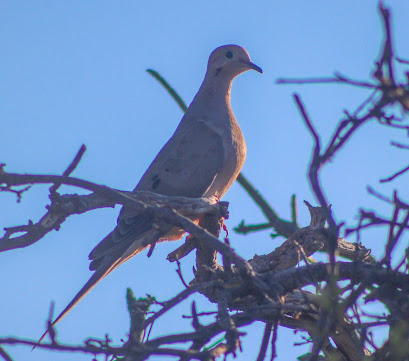The mourning dove (Zenaida macroura) is one of the most abundant and widespread birds in North America. More than 20 million (and sometimes as many as 70 million) are shot each year in the U.S. for sport and meat.
 |
| This mourning dove was seen near Hayfield Road in the Colorado Desert of southeastern California, just south of Joshua Tree NP. |
There are five subspecies: (1) Z. m. marginella in western Canada, western USA and to south central Mexico, the one I've been seeing; (2) Z. m. carolinensis in eastern Canada, eastern USA, Bermuda and the Bahamas; (3) Z. m. macroura, the nominate subspecies, in Cuba, Hispaniola, Puerto Rico and Jamaica; (4) Z. m. clarionensis on Clarion Island (west Mexico); and (5) Z. m. turturilla in Costa Rica and western Panama.
 |
| The rest of the mourning dove photos are from Live Oak Canyon near Redlands, California. I've been seeing them on my early morning walks. |
It has light gray/brown plumage above and is lighter and pinkish below. The wings have black spotting and the outer tail featehrs are white. It has a crescent shaped area of dark feathers below the eye. They have dark eyes with light skin surrounding them. Adult males have bright purple/pink patches on the side of the neck and light pink coloring reaching the breast. The crown also has a bluish/gray color. Females are similar, but more brown and smaller. The legs are reddish and the feet have three forward toes and one backward toe. The beak is short and dark.
Z. m. marginella, our western subspecies, has shorter toes, longer wings, a longer beak and is more muted and lighter in color.



"Mourning," not "morning." I had not realized that. It must have something to do with that quiet "coo coo" they have.
ReplyDelete